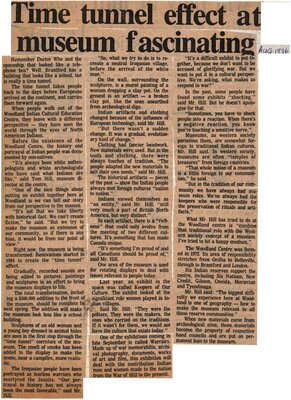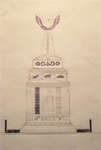"Time Tunnel Effect at Museum Fascinating"
- Publication
- Brantford Expositor, Aug 1986
- Full Text
- Time tunnel effect at museum fascinating
Remember Doctor Who and the spaceship that looked like a telephone box? Well, Brantford has a building that looks like a school, but is really a time tunnel.
The time tunnel takes people back to the days before Europeans arrived on the continent, and carries them forward again.
When people walk out of the Woodland Indian Cultural Education Centre, they leave with a different perspective - they have seen the world through the eyes of North American Indians.
Before the existence of the Woodland Centre, the history and portrayal of Indian people was documented by non-natives.
"It's always been white anthropologists and white archeologists who have said what Indians are like," said Tom Hill, museum director at the centre.
"One of the nice things about putting an exhibit together here at Woodland is we can tell our story from our perspective to the masses.
"It's not that we take liberty with historical fact. We can't create fiction," he said. "But we try to make the museum an extension of our community, so if there is any bias, it would be from our point of view."
Right now, the museum is being transformed. Renovations started in 1984 to create the "time tunnel" effect.
Gradually, recorded sounds are being added to pictures, paintings and sculptures in an effort to bring the museum displays to life.
The total transformation, including a $300,000 addition to the front of the museum, should be complete by next spring. The addition will make the museum look less like a school building.
Sculptures of an old woman and a young boy dressed in animal hides are seen in the first stop through the "time tunnel" corridors of the museum. The smell of smoke has been added to the display to make the scene, near a campfire, more realistic.
The Iroquoian people have been portrayed as fearless warriors who martyred the Jesuits. "Our portrayal in history has not always been the most favorable," said Mr. Hill.
"So, what we try to do is to recreate a neutral Iroquoian village, before the arrival of the white man."
On the wall, surrounding the sculptures, is a mural painting of a woman dropping a clay pot. On the ground is an artifact - a broken clay pot, like the ones unearthed from archeological digs.
Indian artifacts and clothing changed because of the influence of European technology, said Mr. Hill.
"But there wasn't a sudden change. It was a gradual, evolutionary kind of change."
Clothing had fancier beadwork. New materials were used. But in the tools and clothing, there were always touches of tradition. "The people adapted the new materials to suit their own needs," said Mr. Hill.
The historical artifacts - pieces of the past - show the Indian people always met foreign cultures "nation to nation."
Indians viewed themselves as "an entity," said Mr. Hill, "still very much a part of British North America, but very distinct."
In each artifact, there is a "richness" that could only evolve from the meeting of two different cultures. It's something that has made Canada unique.
"It's something I'm proud of and all Canadians should be proud of," said Mr. Hill.
One area of the museum is used for rotating displays to deal with issues relevant to people today.
Last year, an exhibit in the space was called Keepers of Our Culture. The exhibit looked at the significant role women played in Indian villages.
Said Mr. Hill: "They were the potters. They were the makers, the ones who carried on the traditions. If it wasn't for them, we would not have the culture that exists today."
One of the exhibitions coming in late September is called Warriors. Made up of war memorabilia, archival photography, documents, works of art and film, this exhibition will deal with the contribution Indian men and women made to the nation from the War of 1812 to the present.
"It's a difficult exhibit to put together, because we don't want to be accused of glorifying war. But we want to put it in a cultural perspective. We're asking, what makes us respond to war?"
In the past, some people have found some exhibits "shocking," said Mr. Hill. But he doesn't apologize for that.
"Sometimes, you have to shock people into a reaction. When there's a negative reaction, you know you're touching a sensitive nerve."
Museums, as western society perceives them, are somewhat foreign to traditional Indian cultures, Mr. Hill said. In western society, museums are often "temples of treasures" from foreign countries.
"That whole notion of a museum is a little foreign to our communities," he said.
"But in the tradition of our community we have always had museum roles. We've always had the keepers who were responsible for the preservation of rituals and artifacts."
What Mr. Hill has tried to do at the Woodland centre is "combine that traditional role with the Western society concept of a museum. I've tried to hit a happy medium."
The Woodland Centre was formed in 1972. Its area of responsibility stretches from Orillia to Belleville, through to Brantford and London.
Six Indian reserves support the centre, including Six Nations, New Credit, Gibson, Oneida, Moravian and Tyendinaga.
Mr. Hill said: "The biggest difficulty we experience here at Woodland is one of geography - how to make the museum relevant to all these reserve communities."
When new materials come from archeological sites, those materials become the property of respective band councils and are put on permanent loans to the museum.
- Mystery Question
- Do you know the Author who wrote this Article?[Please answer by clicking on the Comments tab]
- Media Type
- Newspaper
- Item Types
- Articles
- Clippings
- Description
- Remember Doctor Who and the spaceship that looked like a telephone box? Well, Brantford has a building that looks like a school, but is really a time tunnel.
- Date of Publication
- Aug 1986
- Subject(s)
- Personal Name(s)
- Hill, Tom
- Corporate Name(s)
- Woodland Cultural Education Centre
- Local identifier
- SNPL002500v00d
- Collection
- Scrapbook #1 by Janet Heaslip
- Geographic Coverage
-
-
Ontario, Canada
Latitude: 43.1668 Longitude: -80.29967
-
- Creative Commons licence
 [more details]
[more details]- Copyright Statement
- Public domain: Copyright has expired according to Canadian law. No restrictions on use.
- Copyright Date
- 1986
- Copyright Holder
- Brantford Expositor
- Contact
- Six Nations Public LibraryEmail:info@snpl.ca
Website:
Agency street/mail address:1679 Chiefswood Rd
PO Box 149
Ohsweken, ON N0A 1M0
519-445-2954



